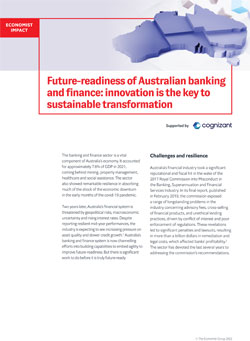
The banking and finance sector is a vital component of Australia’s economy. It accounted for approximately 7.6% of GDP in 2021, coming behind mining, property management, healthcare and social assistance. The sector also showed remarkable resilience in absorbing much of the shock of the economic downturn in the early months of the covid-19 pandemic.
Two years later, Australia’s financial system is threatened by geopolitical risks, macroeconomic uncertainty and rising interest rates. Despite reporting resilient mid-year performances, the industry is expecting to see increasing pressure on asset quality and slower credit growth.1 Australia’s banking and finance system is now channelling efforts into building capabilities to embed agility to improve future-readiness. But there is significant work to do before it is truly future-ready.
Challenges and resilience

Australia’s financial industry took a significant reputational and fiscal hit in the wake of the 2017 Royal Commission into Misconduct in the Banking, Superannuation and Financial Services Industry. In its final report, published in February 2019, the commission exposed a range of longstanding problems in the industry concerning advisory fees, cross-selling of financial products, and unethical lending practices, driven by conflict of interest and poor enforcement of regulations. These revelations led to significant penalties and lawsuits, resulting in more than a billion dollars in remediation and legal costs, which affected banks’ profitability.2 The sector has devoted the last several years to addressing the commission’s recommendations.
The covid-19 pandemic presented an additional challenge to Australia’s economy. The financial sector, however, showed remarkable resilience and played a critical role in absorbing the initial shocks of the pandemic by extending significant support to businesses and households.3 The 2022 half-yearly results of Australia’s big four banks4 noted cash earnings increasing by a combined 5.1%, to A$14.4bn (US$9.4bn), and a 10.6% return on equity—an increase of 20 basis points. This demonstrated not only robust asset growth, but also improvements in asset quality and capital returns, along with closely managed expenses.5
Pre-existing headwinds coupled with growing uncertainties are likely to define the industry’s trajectory and test its resilience further in the coming decade.6 Having invested heavily in risk management and compliance in the wake of the Banking Royal Commission, the sector now has an opportunity to set its sights on sustainable banking and investment as well as digital transformation. Emerging technologies such as machine learning and artificial intelligence (AI) are facilitating data-driven decision-making. They are leading a shift away from product-centric to customer-centric journeys that better serve customer needs while identifying new ways to generate value.7 Furthermore, new digital technologies can be used to drive sustainability in finance by facilitating resource optimisation and environmental risk assessments.8 These can, in turn, support the creation of more effective environmental regulations.
Is the banking sector future-ready?

According to the Future-Ready Business Benchmark, the banking sector, across the ten countries evaluated,9 ranked seventh out of eight industries assessed10 in overall future-readiness. When assessed on business preparedness, the sector ranked last in firm fundamentals, technology and innovative ability, and ESG. However, its score on talent was relatively better, as many firms deemed talent a core component of modernisation. Nevertheless, this has not translated into action, with most surveyed firms lacking a digital talent strategy that would augment employee capacity.
These shortfalls are a “fair assessment” of the Australian banking industry, according to Darren Abbruzzese, CIO Business and Private Banking of NAB. They are more pronounced in incumbent organisations that, until quite recently, operated inside “a regulatory moat” where competition was less vibrant. “Over time, governments and regulators have started to lower those barriers to entry and we’ve seen more competition coming into the marketplace, which has actually been really good for both consumers and the industry,” he says. The influx of new competitors is shining a light on how the industry can better position itself to improve customer experiences with data.
Fintech firms have been successful in creating novel solutions that target customer pain points, capitalising on a demand that has been relatively ignored by traditional banks.11 For example, some fintech firms are offering payday loans that give consumers access to short-term borrowing in 60 minutes. Furthermore, since its launch in mid-2020, open banking has further leveraged big data to provide better services.12 Customers are now able to give permission to accredited businesses to access their banking data, thus opening the door to better deals and tracking of their banking activities.

On the second pillar, progress towards the frontier, the banking sector across the ten countries ranked fifth, ahead of life sciences, manufacturing and healthcare, owing to the industry’s notable performance in ESG (Figure 1). The industry significantly reduced energy consumption in the last fiscal year and noted high renewable energy usage.
Figure 1: Banking leads in environmental progress
Source: Economist Impact
Note: These scores are representative of the ten countries covered under the Future-Ready Business Benchmark.
With regard to talent, the sector, aggregated across the ten countries, ranked second in efficient technology planning to improve productivity and employee engagement. However, it ranked last for talent acquisition and retention. This makes it clear that although the sector is engaging in activities to leverage technologies for greater employee collaboration and efficiency, it is struggling to attract and retain the right talent.
The war on talent is felt by all firms, no matter the size, says Sean O’Malley, CEO of AMP Bank. He is expecting to see firms tap into both domestic and offshore markets to make up for the small local pool. Initiatives are also in place to grow the existing talent market by encouraging more women to study engineering and technology.
In a similar vein, Mr Abbruzzese remarks that “the banks have been responding to this growing competitive environment for a number of years by investing in channels that can produce better outcomes for customers and employees. While this shift towards end-to-end data-driven digitalisation has been ongoing for several years, big organisations don’t change overnight. That slow pivot is occurring and gathering pace.”
Darren Abbruzzese, CIO Business and Private Banking of NAB
Rising mortgage stress, inflation and the cost of living crisis pose further challenges for the Australian banking sector. Inflationary pressures are likely to raise the sector’s already elevated costs due to the ongoing compliance and regulatory programmes.13 The banking sector’s August 2022 risk score14 further deteriorated to 23, from 22, in the previous month, prompting a downgrade from an AA to an A rating (Figure 2).15
Toward a tech-ier and greener future

Moving forward, being future-ready means increased investment into “true” digitalisation that encompasses not just customer facing processes but also innovation that digitally reimagines the banking experience, says Mr O’Malley. “I think we’ll see that truly digital products and services, primarily for consumers, are going to come in a bit of a rush, and come quite quickly,” he says.
Mr Abbruzzese says the pandemic was a “shot in the arm” for banking and financial institutions—and across the economy—forcing organisations and institutions to digitalise rapidly. “That momentum must continue. You have new products and services that come from new competitors that are born in the cloud, born digitally native,” he says. True digitalisation allows customers to self-service, and this helps firms to increase the rate of processing and transacting, leading to faster and more consistent outcomes.
Much of the sector’s progress is hindered by legacy structures and a culture that is still “climbing that hill” in terms of its ability to innovate and deliver quickly, says Mr Abbruzzese. “I wouldn’t say that we’re maximising at the moment, but I think it’s definitely leading to value for both the industry and customers.”
Mr O’Malley says “embedded banking”, and truly digital and ease of switching banks encapsulate the “immediate next future state” of Australian banking and finance. “We will see more and more truly digital switching where it’s very easy for a consumer [to switch service providers] and that isn’t just a digitised version of an old-world process,” he says. Mr O’Malley says banking and finance are likely to adopt an “ease of consolidation” process for banking products, transaction accounts and credit cards, similar to one already in place in the superannuation (pensions) space. Consolidation is “already getting much easier, but I think we’ll see more of that developing in more complex products,” he says.
Sean O’Malley, CEO of AMP Bank
Safeguarding future-readiness
Cybersecurity risk and financial crime are ongoing challenges for the banking sector following an unprecedented increase in cyber-attacks since the pandemic started as criminals adopted new methods of committing theft and identity fraud.16 Although regulations and compliance have tightened significantly, existing security methods are proving insufficient for warding off increasingly sophisticated attacks, whether from organised crime or state-sponsored actors. Such breaches carry not just severe reputational, legal and financial risks, but also pose a threat to the broader financial system. Financial institutions are embracing advanced technologies such as analytics and AI to improve threat detection and crime prevention.
“The amount that the industry is spending on cybersecurity is at unprecedented levels [and] that will only continue to grow,” says Mr Abbruzzese. “You can’t just build a wall around the organisation because, with remote working, there is no wall. People are working from home; we’ve got [data] in the cloud, we use third party services. It’s about embedding security measures throughout the organisation from encryption to user access management, and creating a code of ethics around the use of data.”
Preparing for the future

Climate change likewise poses significant financial risks to the sector if left unaddressed, as the increased frequency of extreme weather events and higher average temperatures threaten to reduce asset values and borrowers’ income streams.17 Mr O’Malley says that although climate change and ESG are on the agenda of many bank boards, the sector can do more to influence other industries and its clients. “A lot of work has been done to understand the domestic and international supply chains of banks and financial institutions, but there’s more to do for banks to understand how we might be able to help businesses understand their supply chains and subsequent emissions impact,” he says.
Likewise, a better understanding of household and consumer footprints creates an opportunity to develop products and services that incentivise emissions reductions. “There is some work starting in this space, some of Australia’s smaller banks are actually leading on that front,” Mr O’Malley says. For example, Bank Australia has pledged to achieve net-zero emissions, including across its lending portfolios, by 2035. It is now offering discounted loans to customers purchasing greener homes—equipped with solar panels and insulation—to improve efficiency in residential energy use.18 “I think we will see more and more development there in the next couple of years,” says Mr O’Malley.

Having weathered several environmental disasters, a pandemic and the painful aftermath of the Banking Royal Commission, the Australian banking and finance sector can be relatively confident about its future. By investing heavily in compliance, simplifying business processes, and shoring up its reputation, the sector has laid solid groundwork for future growth. To be future-ready, it must now increase its capacity to attract and retain talent, embrace emerging technologies, implement processes that allow institutional agility, and develop products and processes that aid the shift to a net-zero economy.
Key takeaways
About the research
This industry analysis forms part of Advance Australia prepare: how to make Australian businesses future-ready, the country-focused segment of a global programme, the Future-Ready Business Benchmark, developed by Economist Impact and supported by Cognizant. This benchmark—based on primary survey data from 2,000 respondents, interviews with business leaders, and secondary data—provides a snapshot of future-readiness across ten countries and eight sectors while examining the broader environment influencing decision-making. It encompasses over 130 indicators grouped into three pillars that measure future-readiness: the external environment, business preparedness and progress towards the frontier. Industry analysis is limited to the latter two pillars, as the pillar on external environment measures future-readiness of the country as a whole. The resulting reports and analysis are available via the programme hub.
We would like to thank Darren Abbruzzese, CIO Business and Private Banking of NAB, and Sean O’Malley, CEO of AMP Bank, for their insights.
- Dring, T. “Australian major banks’ half year results 2022: The only certainty is uncertainty”, EY, May 2022, https://www.ey.com/en_au/economics/australian-banking-half-year-results-2022
- Leslie S, Industry Report, Financial Services, Australia, First Quarter 2022, Economist Intelligence, March 2022.
- Australian banks: first shocks absorbed, bigger tests to come, PWC, Media, 2020, https://www.pwc.com.au/media/2020/australian-banks-first-shocks-absorbed-bigger-tests-to-come.html
- Australia and New Zealand Banking Group, Commonwealth Bank, National Australia Bank and Westpac Banking Group.
- Dring T, Australian major banks’ half year results 2022: The only certainty is uncertainty, EY, May 2022, https://www.ey.com/en_au/economics/australian-banking-half-year-results-2022
- Australian banks: first shocks absorbed, bigger tests to come, PWC, Media, 2020, https://www.pwc.com.au/media/2020/australian-banks-first-shocks-absorbed-bigger-tests-to-come.html
- State of Australian Banks 2022, Industry Overview, Twimbit, May 2022, https://cdn.twimbit.com/uploads/2022/05/10135248/State-of-Australian-Banks-2.pdf
- Accenture, Sustainable finance starts with data and technology, June 17th 2020, https://bankingblog.accenture.com/sustainable-finance-starts-with-data-and-technology
- The benchmark findings are based on survey results and secondary research of the industry in ten countries, namely, Australia, Canada, France, Germany, Netherlands, Norway, Singapore, Sweden, the UK and the US.
- The eight industries are insurance, banking, retail, media, utilities, life sciences, manufacturing and healthcare.
- UNSW, How fintech is disrupting traditional banking, July 28th 2022, https://studyonline.unsw.edu.au/blog/how-fintech-disrupting-traditional-banking
- Australian Banking Association, Open Banking, https://www.ausbanking.org.au/priorities/open-banking/
- Dring, T. “Australian major banks’ half year results 2022: The only certainty is uncertainty”, EY, May 2022, https://www.ey.com/en_au/economics/australian-banking-half-year-results-2022
- Banking sector risk score ranges between 0 (minimum risk) and 100 (maximum risk).
- Australia Financial Services, Australia: Banking Sector Risk, The Economist Intelligence Unit, August 2022.
- Financial Stability Review, Reserve Bank of Australia, October 2021, https://www.rba.gov.au/publications/fsr/2021/oct/pdf/financial-stability-review-2021-10.pdf
- Financial Stability Review, Reserve Bank of Australia, April 2022, https://www.rba.gov.au/publications/fsr/2022/apr/box-a-international-banks-response-to-climate-risk.html
- Fildes, N, Bank Australia sees climate action as key to customer growth, Financial Times, June 13th 2022, https://www.ft.com/content/575a8a28-fb2f-4bd4-b99a-d801bac769e7






















